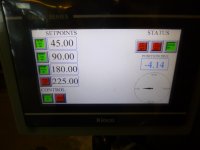I assume on the HMI then you have bit fields like:
So if Bend 1 & Bend 2 is selected
Bend 1 [0/1] "1"
Bend 2 [0/1] "1"
Bend 3 [0/1] "0"
Bend 4 [0/1] "0"
Then pressing the forward button it will go to position 1 & do the bend.
Operator presses the reverse button it goes back to start position
Operator presses forward button it goes to position 2 & do the bend
Operator presses reverse button goes back to start position.
If pressed again it repeats the selected bend profile, is that correct as above ?
So if Bend 1 & Bend 2 is selected
Bend 1 [0/1] "1"
Bend 2 [0/1] "1"
Bend 3 [0/1] "0"
Bend 4 [0/1] "0"
Then pressing the forward button it will go to position 1 & do the bend.
Operator presses the reverse button it goes back to start position
Operator presses forward button it goes to position 2 & do the bend
Operator presses reverse button goes back to start position.
If pressed again it repeats the selected bend profile, is that correct as above ?






